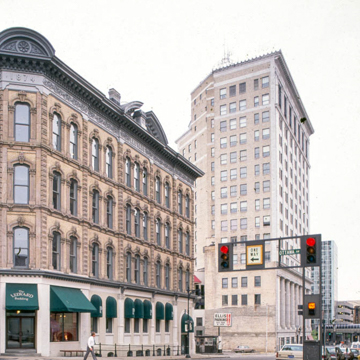You are here
Ledyard Building (Ledyard Block)
With its massive cream brick exterior heavily articulated with elaborate Ionia sandstone window enframements and a magnificent florid metal-covered entablature, the Ledyard Block is one of the outstanding Italianate commercial blocks remaining in Michigan. Originally serving as stores, offices, and a hotel, the building was constructed for William B. Ledyard (1811–1890), banker and businessman, as one of several investments downtown. The Ledyard Block is part of the remarkable streetscape of splendid Round Arch mode and Italianate commercial buildings at 109–125 Ottawa Avenue NW and at 102–124 Monroe Center, built to replace the frame buildings destroyed by fire in September 1857. Twenty-five buildings along both sides of Monroe, between Market Street and Ottawa Avenue, were destroyed at that time. Today the Ledyard Block has been rehabilitated with a concourse and atrium that link it with commercial buildings to the south.
Writing Credits
If SAH Archipedia has been useful to you, please consider supporting it.
SAH Archipedia tells the story of the United States through its buildings, landscapes, and cities. This freely available resource empowers the public with authoritative knowledge that deepens their understanding and appreciation of the built environment. But the Society of Architectural Historians, which created SAH Archipedia with University of Virginia Press, needs your support to maintain the high-caliber research, writing, photography, cartography, editing, design, and programming that make SAH Archipedia a trusted online resource available to all who value the history of place, heritage tourism, and learning.


